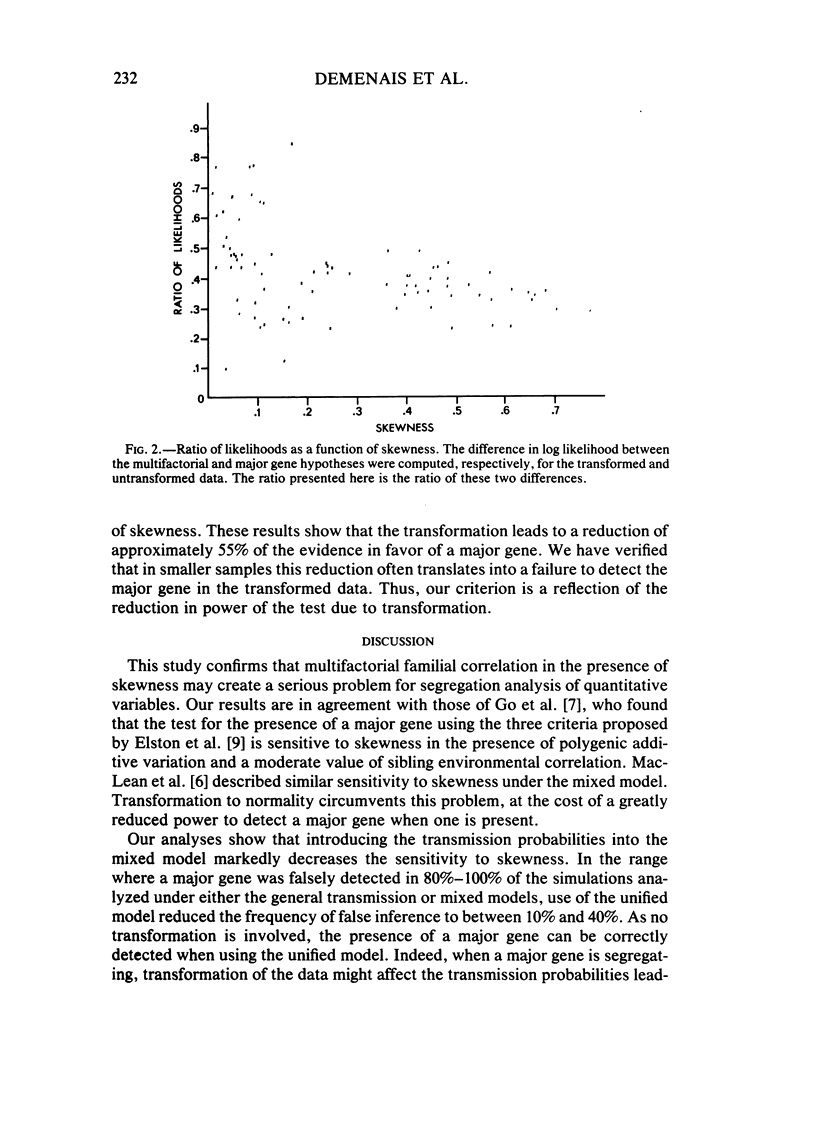Abstract
The resolution between skewness in the distribution of a quantitative trait and segregation of a major gene is a difficult issue in family studies. Quantitative data were simulated on six-member nuclear families in order to study the behavior of the unified model under these circumstances. Replicates of 100 nuclear families were generated assuming a multifactorial model with skewness. In the range where a major gene was falsely detected in 80%-100% of the simulations analyzed under the transmission probability or mixed models, use of the unified model reduces the frequency of false inference to between 10% and 40%. This protection against a false conclusion requires estimation of the three transmission probabilities and testing hypotheses of Mendelian transmission and equal transmission probabilities. Alternatively, it was shown that use of a transformation to remove skewness induced by a major gene leads to a decrease of power of approximately 55%. These results suggest that the unified model may obviate the need to compare analyses performed on transformed and untransformed data, particularly when skewness is low (less than 0.2) or high (greater than 0.4). For intermediate skewness (0.2-0.4), estimating segregation parameters under the mixed model simultaneously with a transformation to remove residual skewness can be considered as an alternative method.
Full text
PDF






Selected References
These references are in PubMed. This may not be the complete list of references from this article.
- Eaves L. J. Errors of inference in the detection of major gene effects on psychological test scores. Am J Hum Genet. 1983 Nov;35(6):1179–1189. [PMC free article] [PubMed] [Google Scholar]
- Elston R. C., Namboodiri K. K., Glueck C. J., Fallat R., Tsang R., Leuba V. Study of the genetic transmission of hypercholesterolemia and hypertriglyceridemia in a 195 member kindred. Ann Hum Genet. 1975 Jul;39(1):67–87. doi: 10.1111/j.1469-1809.1975.tb00109.x. [DOI] [PubMed] [Google Scholar]
- Elston R. C. Segregation analysis. Adv Hum Genet. 1981;11:63-120, 372-3. doi: 10.1007/978-1-4615-8303-5_2. [DOI] [PubMed] [Google Scholar]
- Elston R. C., Stewart J. A general model for the genetic analysis of pedigree data. Hum Hered. 1971;21(6):523–542. doi: 10.1159/000152448. [DOI] [PubMed] [Google Scholar]
- Go R. C., Elston R. C., Kaplan E. B. Efficiency and robustness of pedigree segregation analysis. Am J Hum Genet. 1978 Jan;30(1):28–37. [PMC free article] [PubMed] [Google Scholar]
- Lalouel J. M., Rao D. C., Morton N. E., Elston R. C. A unified model for complex segregation analysis. Am J Hum Genet. 1983 Sep;35(5):816–826. [PMC free article] [PubMed] [Google Scholar]
- MacLean C. J., Morton N. E., Lew R. Analysis of family resemblance. IV. Operational characteristics of segregation analysis. Am J Hum Genet. 1975 May;27(3):365–384. [PMC free article] [PubMed] [Google Scholar]
- Maclean C. J., Morton N. E., Elston R. C., Yee S. Skewness in commingled distributions. Biometrics. 1976 Sep;32(3):695–699. [PubMed] [Google Scholar]
- Morton N. E., MacLean C. J. Analysis of family resemblance. 3. Complex segregation of quantitative traits. Am J Hum Genet. 1974 Jul;26(4):489–503. [PMC free article] [PubMed] [Google Scholar]
- Ott J. Detection of rare major genes in lipid levels. Hum Genet. 1979 Sep 2;51(1):79–91. doi: 10.1007/BF00278296. [DOI] [PubMed] [Google Scholar]


